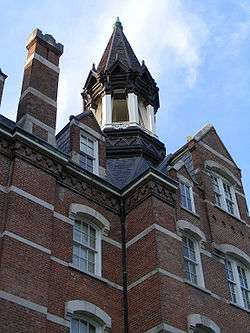Fisk University
Fisk University is a private historically black university in Nashville, Tennessee. The university was founded in 1866 and its 40-acre (160,000 m2) campus is a historic district listed on the National Register of Historic Places.
 | |
Former names | The Fisk Freed Colored School |
|---|---|
| Motto | Her sons and daughters are ever on the altar[1] |
| Type | Private, HBCU |
| Established | 1866 |
Religious affiliation | United Church of Christ (historically related) |
Academic affiliations | UNCF ORAU CIC |
| President | Kevin D. Rome |
Academic staff | 70 full-time |
| Students | 780[2] |
| Location | , , United States 36.1688°N 86.8047°W |
| Campus | Urban, 40 acres (16 ha) |
| Colors | Gold and Blue |
| Nickname | Bulldogs |
Sporting affiliations | NAIA – Independent (previously GCAC) |
| Mascot | The Fisk Bulldog |
| Website | www |
 | |
In 1930, Fisk was the first African-American institution to gain accreditation by the Southern Association of Colleges and Schools (SACS). Accreditations for specialized programs soon followed. Although the university remains accredited by SACS, the university was placed on probation in June 2018.[3]
History
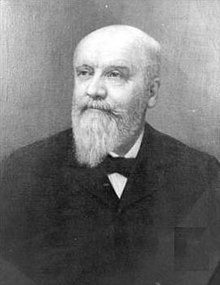
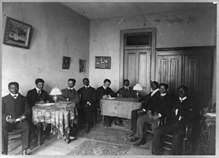
Founding
Fisk Free Colored School opened on January 9, 1866, shortly after the end of the Civil War. It was founded by John Ogden, Erastus Milo Cravath, and Edward Parmelee Smith of the American Missionary Association for the education of freedmen in Nashville. Fisk was one of several schools and colleges that the association helped found across the South to educate freed slaves following the Civil War. The school is named for Clinton B. Fisk, a Union general and assistant commissioner of the Freedmen's Bureau of Tennessee. Fisk secured a site to house the school in a former military barracks near Union Station and provided $30,000 for its endowment.[4][5]
The American Missionary Association's work was supported by the United Church of Christ, which retains an affiliation with the university.[6] Fisk is the oldest higher education institution in Nashville.[7]
19th Century
Enrollment rose to 900 in the first several months following the school's opening, indicating the strong desire for education among local freedmen. Student ages ranged from seven to seventy.[4]
During the nation's Reconstruction era, the Tennessee General Assembly passed legislation to enable free public education, which caused a need to increase teacher training. In 1867 the Fisk Free Colored School was reorganized and incorporated as Fisk University to focus on higher education.[5][4] James Dallas Burrus, John Houston Burrus, Virginia E. Walker, and America W. Robinson were the first students to enroll at the university. In 1875, the two Burruses and Walker graduated from Fisk and became the first African-American students to graduate from a liberal arts college south of the Mason–Dixon line.[8][9]
In 1870 Adam K. Spence became the school's principal. Spence developed plans to expand and move the school to a larger campus in north Nashville on a site that had been Fort Gillem, a Union army base.[10][11] To raise money for the school's initiatives, his wife Catherine Mackie Spence traveled throughout the United States to set up mission Sunday schools in support of Fisk students, organizing endowments through the American Missionary Association.[12] With a strong interest in religion and the arts, Adam Spence supported the founding of a student choir; they were the start of the Fisk Jubilee Singers.
With the school facing financial distress, the choir went on tour to raise funds in 1871, led by professor and university treasurer George L. White.[4][13] They toured the U.S. and Europe and became a sensation, singing before Ulysses S. Grant, Mark Twain, Queen Victoria; popularizing spirituals written by Wallace Willis such as "Swing Low Sweet Chariot"; and changing racial stereotypes.[14][15][13] Their tour raised nearly $50,000 and funded construction of Jubilee Hall. It was the first building built for the education of freedmen in the South and is now a National Historic Landmark.[16]
Fisk co-founder Cravath returned in 1875 and became the university's first president.[17] He oversaw an active construction program and expansion of the school's curriculum offerings to include liberal arts, theology, and teacher training. By the turn of the 20th century, the university had strengthened its reputation, built several campus buildings, added African-American teachers and staff to the university, and enrolled a second generation of students.[16][17]
20th Century
Fisk's dedication to liberal arts education at the turn of the century distinguished it from many other black colleges and universities that emphasized vocational training.[18] The school established a department of social science in 1910, founded and directed by George E. Haynes. It was the first social work training center for African-American graduate students and a model for those established at other universities.[19][20] The school was criticized by some at the time for fostering an elitist reputation.[21]
From 1915 to 1925, Fayette Avery McKenzie was president of Fisk. McKenzie's tenure, before and after World War I, was during a turbulent period in American history. In spite of many challenges, McKenzie developed Fisk as the premier all Black university in the United States, secured Fisk's academic recognition as a standard college by the Carnegie Foundation, Columbia University and the University of Chicago, raised a $1 million endowment fund to ensure quality faculty, and laid a foundation for Fisk's accreditation and future success.[22] McKenzie was eventually forced to resign when his strict policies on dress code, extracurricular activities, and other aspects of student life led to student protests in 1924 and 1925.
Thomas Elsa Jones became the university's fourth president in 1925. He sought to diversify the university's faculty and further build the school's reputation.[23] In 1930, Fisk became the first historically black college to gain accreditation by the Southern Association of Colleges and Schools. It was also the first such institution approved by the Association of American Universities in 1933. Accreditations for specialized programs soon followed.
In 1946, Charles S. Johnson became the university's sixth president and first African-American president.[17] Johnson was a premier sociologist, a scholar who had also been the editor of Opportunity magazine, a noted periodical of the Harlem Renaissance. Johnson expanded the school's Institute of Race Relations, which was established in 1942. The institute conducted research and fostered discussion about racial disparity in the U.S. and would later help develop strategies for desegregation in schools, employment, and the military.[23][24][25][18] In 1949, Fisk received the Stieglitz Collection of modern art from photographer and arts patron Alfred Stieglitz.
In 1952, Fisk was the first predominantly black college to earn a Phi Beta Kappa charter.[26] Organized as the Delta of Tennessee Chapter of the Phi Beta Kappa National Honor Society that December, the chapter inducted its first student members on April 4, 1953.
In 1960, Fisk students joined other black leaders in the Nashville sit-ins, nonviolent protests against segregation at lunch counters in the city during the civil rights movement.[27] Martin Luther King, Jr., spoke at the university in May 1960 in response to civil rights movement in the city.[28] Fisk students John Lewis and Diane Nash were leaders during the protests, which led to Nashville becoming the first major city in the South to desegregate lunch counters.[29] The two became early leaders of the national Student Nonviolent Coordinating Committee (SNCC).
On April 8, 1967, a riot occurred near the Fisk and Tennessee State University campuses after Stokely Carmichael spoke at Vanderbilt University.[30] Although it was viewed as a "race riot", it had classist characteristics.[30] Protestors marched from Fisk to the Nashville courthouse to protest police brutality during the riots.[31]
In 1978 Fisk's campus was recognized as a National Historic Landmark.[5] The campus underwent significant restoration in the 1990s through assistance from a U.S. Congressional Grant.[17]
21st Century
From 2004 to 2013, Fisk was directed by its 14th president, Hazel O'Leary, former Secretary of Energy under President Bill Clinton. She was the second woman to serve as president of the university. On June 25, 2008, Fisk announced that it had successfully raised $4 million during the fiscal year ending June 30. It ended nine years of budget deficits and qualified for a Mellon Foundation challenge grant.[32][33] However, Fisk still faced significant financial hardship, and said that it may need to close its doors unless its finances improved.[34]
H. James Williams, served as president from February 2013 to September 2015. Williams had previously been dean of the Seidman College of Business at Grand Valley State University in Michigan and, before that, an accounting professor at Georgetown University, Florida A&M, and Texas Southern University.[35][36][37] Williams was succeeded by interim president Frank Sims.[38] In March 2017 the Fisk board of trustees announced that Kevin Rome would be Fisk university's seventeenth president.[39]
In June 2017, a service in memory of 1892 lynching victim Ephraim Grizzard was held in the Fisk Memorial Chapel. A plaque memorializing Grizzard and two other lynching victims—is brother Henry and Samuel Smith—was installed at St. Anselm's Episcopal church in Nashville.[40]
In 2018 the Southern Association of Colleges and Schools placed the university on probation. The accreditor cited failings related to financial responsibility, control of research funds, and federal and state responsibility.[41] Fisk announced a fundraising record and increased enrollment the following year.[42]
Campus
Fisk University Historic District | |
| Location | Roughly bounded by 16th and 18th Aves., Hermosa, Herman and Jefferson Sts. Nashville, Tennessee |
|---|---|
| Architectural style | Italianate; Queen Anne |
| NRHP reference No. | 78002579 |
| Added to NRHP | February 9, 1978 |
Fisk's 40-acre campus was dedicated in 1876. It sits on a small hill approximately two miles northwest of downtown that was previously Fort Gillem, a Union fort during the Civil War.[43] The campus lies on Jefferson Street, a historic center of Nashville's African-American community.
The Fisk University Historic District was added to the National Register of Historic Places in 1978. Notable campus buildings that contribute to the historic district include:
- The Carl Van Vechten Gallery was built in 1888. It served as the school's gymnasium before becoming an art gallery. The building houses the university's renowned Stieglitz Collection of modern art. It is named for photographer Carl Van Vechten.[17][44]
- Carnegie Hall was originally built as a library in 1908. It is the first major building by Moses McKissack III, co-founder of the first African-American owned architecture firm in the United States.[45]
- Cravath Hall, named for the university's first president Erastus Milo Cravath and completed in 1930, is an eight-story building originally used as a library. It was designed by Henry Hibbs. The building features a series of murals by painter Aaron Douglas, which he described as a "panorama of the development of Black people in this hemisphere, in the new world."[46] The murals have been described as the most ambitious works of his career.[47] The building now houses administrative offices.
- Fisk Memorial Chapel was built in 1892 in the Victorian style. At the time it was the largest building for African Americans to gather in the country.[48] The chapel hosts campus functions and public events such as concerts, lectures, and graduations. The building was restored and rededicated in 1992.[49]
- Jubilee Hall, completed in 1876, is the oldest permanent building for the higher education of African Americans in the United States.[50] It is named for the Fisk Jubilee Singers who toured the country to raise funds for its construction. The six-story, L-shaped building is noted for its Victorian Gothic architecture.[51]
- Talley Brady Hall, built in 1931, is the first modern chemistry building at an historically black university. It is named for Thomas E. Talley and St. Elmo Brady, two notable African American chemists and faculty members.[52]
Additional campus buildings listed on the register include Little Theater, Harris Music Building, numerous residential structures, and a limestone wall built around 1873.[48]
In the 1930s the university hired the Olmsted Brothers firm to lead a master design of its campus at this time, resulting in the Beaux-Arts landscape.[53][54]
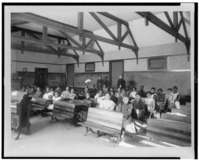 Students and teachers in training school (between 1890 and 1906)
Students and teachers in training school (between 1890 and 1906) Theological Hall (later Bennett Hall). The building was demolished.[55]
Theological Hall (later Bennett Hall). The building was demolished.[55]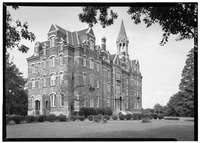 Jubilee Hall
Jubilee Hall- Fisk Memorial Chapel
.jpg) Cravath Hall
Cravath Hall Interior of Cravath Hall
Interior of Cravath Hall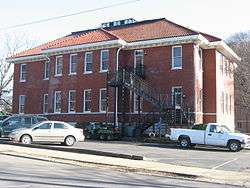 Carnegie Hall
Carnegie Hall
Music, art, and literature collections
Library Collections
Fisk is the home of a music literature collection founded by the noted Harlem Renaissance figure Carl Van Vechten, for whom the campus museum is named.[56] It also holds a substantial collection of materials associated with Charles W. Chestnutt.[57]
Aaron Douglas Murals
Harlem Renaissance painter Aaron Douglas was commissioned to paint murals for the new campus library, Cravath Hall, in 1930. Douglas described them a "panorama of the development of Black people in this hemisphere, in the new world." Douglas returned to Fisk in 1939 to teach and later served as chair of the university's art department. The murals were restored in 2003.[58][59]
Alfred Stieglitz Collection
In 1949, Georgia O'Keeffe wife, and Executrix of her late husband's estate, donated to Fisk a number of paintings that had belonged to her husband (in accordance with the terms of his will), the photographer and art patron Alfred Stieglitz. The collection consists of 101 works by important artists, including European modernists Paul Cézanne, Pierre-Auguste Renoir, Pablo Picasso and Diego Rivera, as well as American artists Marsden Hartley, Arthur Dove and Charles Demuth and works by O'Keeffe.[60]
In 2005, mounting financial difficulties and deteriorating conditions in the gallery led the University trustees to vote to sell two of the paintings, O'Keeffe's "Radiator Building" and Hartley's "Painting No. 3," together estimated to be worth up to 45 million U.S. dollars. The sale was challenged by the Georgia O'Keeffe Museum, the legal guardians of her estate. This challenge failed. A joint agreement was established between Fisk University and the Crystal Bridges Museum of American Art.[61][62][63][64] The two museums now share the works' presentation and display rights of the Stieglitz collection, (ownership remains with Fisk University, in accord with the terms of Stieglitz's estate). Presentation and display rights, rotate between Fisk University and Crystal Bridges Museum, every two years. In 2016, as part of the university's sesquicentennial celebration, the collection was displayed at the newly renovated Carl Van Vechten Gallery.[60]
Science programs
Fisk University has a strong record of academic excellence: it has graduated more African Americans who go on to earn PhDs in the natural sciences than any other institution.[65]
Fisk-Vanderbilt Bridge Program
Started in 2004,[66] the Fisk-Vanderbilt bridge program helps underrepresented groups gain access to Ph.D. programs in STEM fields. The partnership between a small, historically black college and a major research university aims to diversify doctoral study.[67] The program, which has received money from NASA, the National Science Foundation, and the Integrative Graduate Education and Research Traineeship,[68] provides a scholarship for a master's degree at Fisk University and close mentorship for students who go on to a Ph.D.[66] Since 2004, 21 students in the program have completed a Ph.D., with another 56 currently pursuing graduate study.[66] The program has a success rate far higher than the national average for completion of Ph.D. programs, which is about 50%.[69]
Rankings
| University rankings | |
|---|---|
| National | |
| Forbes[70] | 642 |
| Liberal arts colleges | |
| U.S. News & World Report[71] | 164–215 |
| Washington Monthly[72] | 162 |
- For 2020, U.S. News & World Report ranked Fisk University tied for 35th for best undergraduate teaching and 164–215 overall among national liberal arts colleges, and 9th among historically black colleges and universities in the U.S.[73]
- For 2019, Washington Monthly ranked Fisk 162nd among liberal arts colleges in the U.S. based on their contribution to the public good, as measured by social mobility, research, and promoting public service.[74]
- Forbes ranks Fisk 642nd on its 2019 "America's Top Colleges" list of 650 colleges, universities and service academies.[75]
Athletics
Fisk University teams, nicknamed athletically as the Bulldogs, are part of the National Association of Intercollegiate Athletics (NAIA)[76] Division I level, primarily competing in the Gulf Coast Athletic Conference (GCAC).[77] Men's sports include basketball, cross country, tennis and track & field; women's sports include basketball, cross country, softball, tennis, track & field and volleyball.
Notable alumni
| Name | Class year | Notability | Reference(s) |
|---|---|---|---|
| Lil Hardin Armstrong | 1915 | jazz pianist/composer, second wife of Louis Armstrong | |
| Constance Baker Motley | 1941–1942 | first African-American woman elected to the New York State Senate | |
| Marion Barry | 1960 | former mayor of Washington, D.C. | |
| Mary Frances Berry | former Chair, United States Commission on Civil Rights; former Chancellor University of Colorado at Boulder | ||
| John Betsch | 1967 | jazz percussionist | |
| Joyce Bolden | first African-American woman to serve on the Commission for Accreditation of the National Association of Schools of Music | ||
| Otis Boykin | 1942 | inventor, control device for the heart pacemaker | |
| St. Elmo Brady | first African American to earn a doctorate in Chemistry | ||
| Virginia E. Walker Broughton | 1875, 1878 | author and Baptist missionary | [78][79][80] |
| Cora Brown | first African-American woman elected to a state senate | ||
| James Dallas Burrus | 1875 | educator | |
| John Houston Burrus | 1875 | educator | 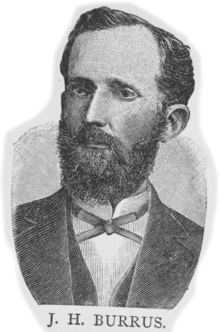 |
| Henry Alvin Cameron | 1896 | educator, decorated World War I veteran | |
| Elizabeth Hortense (Golden) Canady | past national president of Delta Sigma Theta sorority | ||
| Alfred O. Coffin | first African American to earn a doctorate in zoology | ||
| Malia Cohen | 2001 | San Francisco District 10 Supervisor 2010 – Present | |
| Johnnetta B. Cole | anthropologist, former President of Spelman College and Bennett College | ||
| Neal Craig | 1971 | NFL Cornerback for Cincinnati Bengals, Buffalo Bills, and Cleveland Browns | |
| Arthur Cunningham | 1951 | musical composer, studied at Juilliard and Columbia University | |
| William L. Dawson (politician) | 1909 | U.S. Congressman (1943–1970) | 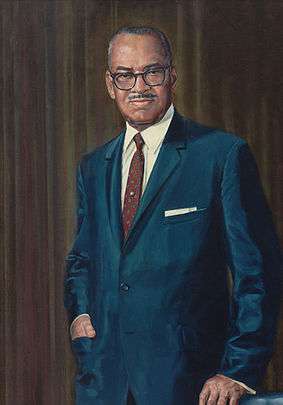 |
| Charles Diggs | United States House of Representatives Michigan (1955–1980) |  | |
| Mahala Ashley Dickerson | 1935 | first black female attorney in the state of Alabama and first black president of the National Association of Women Lawyers | |
| Rel Dowdell | 1993 | acclaimed filmmaker | |
| W. E. B. Du Bois | 1888 | sociologist, scholar, first African-American to earn a Ph.D. from Harvard |  |
| James J. Durham | 1880, 1885 | Founder of Morris College | |
| Althea Brown Edmiston | 1901 | Presbyterian missionary in Belgian Congo | |
| Venida Evans | 1969 | actress, best known for IKEA commercials | |
| Etta Zuber Falconer | 1953 | first African-American woman to receive a Ph.D. in mathematics; former Chair, mathematics department at Spelman College | |
| John Hope Franklin | 1935 | historian, professor, scholar, author of landmark text From Slavery to Freedom | 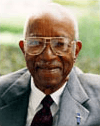 |
| Victor O. Frazer | United States House of Representatives (1995–1997) | ||
| Alonzo Fulgham | former acting chief and operating officer of the United States Agency for International Development (USAID) | ||
| Nikki Giovanni | 1967 | poet, author, professor, scholar | 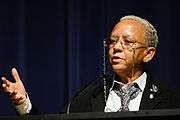 |
| Louis George Gregory | posthumously, a Hand of the Cause in Bahá'í Faith | ||
| Eliza Ann Grier | 1891 | first African-American female physician in Georgia | 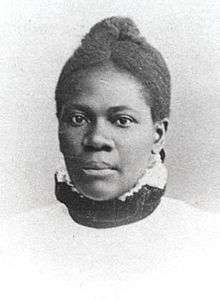 |
| Kevin Hales | professor, Africologist, Fulbright Scholar, NEH Scholar, Teaching Excellence Professor (Scholar of global African culture) | ||
| Alcee Hastings | U.S. Congressman and former U.S. district court judge | ||
| Roland Hayes | concert singer | ||
| Perry Wilbon Howard | Assistant U.S. Attorney General under President Herbert Hoover | ||
| Elmer Imes | 1903 | renowned physicist and second African-American to earn a Ph.D in Physics | |
| Esther Cooper Jackson | 1940 | Founding editor of Freedomways Journal | |
| Lena Terrell Jackson | 1885 | educator in Nashville for over 50 years |  |
| Leonard Jackson (actor) | 1952 | Actor, Five on the Black Hand Side; The Color Purple | |
| Robert James | former NFL cornerback | ||
| Judith Jamison | pioneering dancer and choreographer; former artistic Director, Alvin Ailey American Dance Theater | ||
| Ted Jarrett | R&B recording artist and producer | ||
| Dr. Charles Jeter | 1971 | father of Derek Jeter | |
| Ben Jobe | 1956 | legendary basketball coach, Southern University | |
| Lewis Wade Jones | 1931 | sociologist; Julius Rosenwald Foundation Fellow at Columbia University | |
| Ella Mae Johnson | 1921 | at age 105 years old, Ella Mae Johnson traveled to Washington, DC to attend the inauguration of Barack Obama | |
| Mame Stewart Josenberger | 1888 | businesswoman and clubwoman in Arkansas |  |
| Anne Gamble Kennedy | 1941 | Pianist, professor, and piano accompanist for the Fisk Jubilee Singers | |
| Matthew Kennedy | 1947 | Pianist, professor, and former director of the Fisk Jubilee Singers | |
| Mathew Knowles | 1973 | father and former manager of Beyoncé, founder and owner of Music World Entertainment, and adjunct professor at Texas Southern University | |
| Dr. John Angelo Lester | 1895 | Professor Emeritus of Physiology, Meharry Medical College | |
| Nella Larsen | 1908 | novelist, Harlem Renaissance era | |
| Julius Lester | 1960 | author of children's books and former professor at the University of Massachusetts Amherst | |
| David Levering Lewis | 1956 | two-time Pulitzer Prize Winner |  |
| John Lewis | 1967 | Congressman, civil rights activist, former President of Student Nonviolent Coordinating Committee (SNCC) |  |
| Hettie Simmons Love | 1943 | first African-American to earn an MBA at the Wharton School of Business at the University of Pennsylvania | |
| Jimmie Lunceford | 1925 | famous bandleader in the swing era | |
| Aubrey Lyles | 1903 | vaudeville performer | |
| Mandisa | 2001 | Grammy Award-winning and Dove Award-nominated Christian contemporary singer/songwriter, ninth-place finalist in the fifth season (2006) of American Idol | |
| Ariana Austin Makonnen | philanthropist and member of the Ethiopian Imperial Family | ||
| Patti J. Malone | 1880 | Fisk Jubilee Singer | |
| Louis E. Martin | 1933 | Godfather of Black Politics | |
| Fatima Massaquoi | 1936 | pioneering Liberian educator | [81] |
| Jedidah Isler | 2007 | Isler became the first African-American woman to receive a PhD in Astrophysics from Yale University in 2014 | [82] |
| Wade H. McCree | 1941 | second African-American United States Solicitor General; Justice, U.S. Court of Appeals for the Sixth Circuit | 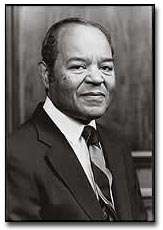 |
| Samuel A. McElwee | 1883 | State Senator during the Reconstruction Era and the first African American elected three times to the Tennessee General Assembly | |
| Robert McFerrin | first African American male to sing at the Metropolitan Opera and father of Bobby McFerrin | ||
| Leslie Meek | 1987 | Administrative Law Judge, wife of Congressman Kendrick Meek | |
| Theo Mitchell | 1960 | Senator, South Carolina General Assembly | |
| Undine Smith Moore | first Fisk graduate to receive a scholarship to Juilliard, Pulitzer Prize Nominee | ||
| Diane Nash | founding member of SNCC | ||
| Rachel B. Noel | politician; first African-American to serve on the Denver Public Schools Board of Education | ||
| Lonnie H. Norris, D.M.D., M.P.H. | 1964 | first African American Dean in the history of Tufts University School of Dental Medicine. | [83] |
| Donna M. Norris M.D. | 1964 | psychiatrist and the first black and first woman speaker at the assembly of the American Psychiatric Association. | [84] |
| Hon. Hazel O'Leary | former U.S. Secretary of Energy |  | |
| Lucius T. Outlaw, Jr. | Philosophy professor at Vanderbilt University[85] | ||
| J.O. Patterson, Jr. | 1958 | first African American to occupy the office of Mayor of Memphis. Tennessee State Representative, State Senator, Memphis Councilman, Jurisdictional Bishop in the Church of God in Christ | |
| Helen Phillips | 1928 | first African-American to perform with the Metropolitan Opera Chorus | |
| Annette Lewis Phinazee | 1939 | first black woman to earn a doctorate in library sciences from Columbia University | |
| Alma Powell | wife of Gen. Colin Powell | ||
| Cecelia Cabaniss Saunders | 1903 | director of Harlem YWCA, 1914-1947 | |
| Lorenzo Dow Turner | 1910 | linguist and Chair, African Studies at Roosevelt University | |
| A. Maceo Walker | 1930 | businessman, Universal Life Insurance, Tri-State Bank | |
| Ron Walters | 1963 | scholar of African-American politics, Chair, Afro-American Studies Brandeis University | |
| Margaret Murray Washington | 1890 | Lady Principal of Tuskegee Institute and third wife of Booker T. Washington | |
| Ida B. Wells | American civil rights activist and women's suffrage advocate |  | |
| Charles H. Wesley | 1911 | President of Wilberforce University from 1942 to 1947, and President of Central State College from 1947–1965; third African-American to receive a Ph.D. from Harvard | |
| Kym Whitley | actress, comedian | ||
| Frederica Wilson | 1963 | U.S. Representative for Florida's 17th congressional district |  |
| Tom Wilson (producer) | 1953 | music producer, best known for his work with Bob Dylan and Frank Zappa | |
| Frank Yerby | 1938 | first African-American to publish a best-selling novel |
Notable faculty
| Name | Department | Notability | Reference |
|---|---|---|---|
| Camille Akeju | Art | Art historian and museum administrator | [86] |
| Ebenezer Ako-Adjei | African studies | Ghanaian politician and founding member of the United Gold Coast Convention | |
| Arna Bontemps | Librarian | Head librarian and Harlem Renaissance poet | [87] |
| Aaron Douglas | Art | Harlem Renaissance painter, illustrator, and muralist | [88] |
| Robert Hayden | United States Poet Laureate (1976–1978) | [89] | |
| Charles Spurgeon Johnson | President, Research | First African-American president of Fisk University | [90] |
| James Weldon Johnson | Literature | Author, poet, and civil rights activist; wrote the poem on which the song "Lift Ev'ry Voice and Sing" is based (also known as the Black national anthem) | [91] |
| Thomas Elsa Jones | President | Fifth president of Fisk University | [92] |
| Percy Lavon Julian | Chemistry | Chemist and second African-American member of the National Academy of Sciences | [93] |
| Anne Gamble Kennedy | Music | Concert pianist, piano professor, and accompanist for the Fisk Jubilee Singers | |
| Matthew Kennedy | Music | Concert pianist, piano professor, and director of the Fisk Jubilee Singers (1957–1986 intermittently) | [94] |
| John Oliver Killens | Writer in Residence | Two-time Pulitzer Prize nominee | [95] |
| Lee Lorch | Mathematics | Mathematician and civil rights activist. Fired in 1955 for refusing to testify before the House Un-American Activities Committee. | [96] |
| Hazel R. O'Leary | President | First woman and first African-American U.S. Secretary of Energy; fourteenth president of Fisk University | [97] |
| Helen Clarissa Morgan | Latin | First woman to be appointed professor of Latin (1869–1907) at a coeducational college | [98] |
| Robert E. Park | Sociology | Sociologist of the Chicago School | [99] |
| John W. Work III | Music | Choir director, ethnomusicologist, and scholar of Afro-American folk music | [100] |
References
- "Welcome". Fisk Memorial Chapel. Retrieved June 28, 2010.
- https://nces.ed.gov/collegenavigator/?q=Fisk+University&s=all&id=220181
- Lederman, Doug (June 25, 2018). "Southern Accreditor Places 4 Institutions on Probation". Inside Higher Ed. Retrieved June 28, 2018.
- Randal Rust. "Fisk University". Tennessee Encyclopedia. Retrieved June 20, 2020.
- "Fisk University History". Fisk University. Retrieved June 20, 2020.
- "History of Fisk". Fisk University. Archived from the original on July 6, 2012. Retrieved July 8, 2012.
- "Fisk University". UNCF. Retrieved June 20, 2020.
- Richardson, Joe M. "A negro success story: James Dallas Burrus". The Journal of Negro History 50, no. 4 (1965): 274–282.
- "Blacks and the American Missionary Association". United Church of Christ. Retrieved June 20, 2020.
- Cohen, Rodney T. (2001). Fisk University. Arcadia Publishing. ISBN 978-0-7385-0677-7.
- "Fisk University | The Cultural Landscape Foundation". tclf.org. Retrieved June 21, 2020.
- Biographical note: Adam Knight Spence, Spence Family Collection, Fisk University Library, accessed 3 Mar 2009. Link via the Internet Archive, accessed 15 August 2013.
- Thanki, Juli. "141 years later, Fisk Jubilee Singers return to England". The Tennessean. Retrieved June 20, 2020.
- Mitchell, Reavis L., Jr., Fisk University, The Tennessee Encyclopedia of History and Culture, 2002, accessed 3 Mar 2009
- "Jubilee Singers: Sacrifice and Glory | American Experience | PBS". www.pbs.org. Retrieved June 20, 2020.
- "Fisk University", The Tennessee Encyclopedia of History and Culture, 2002, accessed 3 Mar 2009. Quote: "When the American Missionary Association declined to assume the financial responsibility of the Jubilee Singers, Professor George L. White, Treasurer of the University, took the responsibility upon himself and started North in 1871 with his troupe. On April 12, 1873, the Jubilee Singers sailed for England where they sang before a fashionable audience in the presence of the Queen, who expressed her gratification at the performance."
- "Fisk 2018/2020 Undergraduate Bulletin" (PDF). Fisk University. Retrieved June 20, 2020.
- "Fisk University | American Experience | PBS". www.pbs.org. Retrieved June 21, 2020.
- "Haynes, George Edmund (1880 – 1960)". Social Welfare History Project. October 2, 2011. Retrieved June 21, 2020.
- Neverdon-Morton, Cynthia (1989). Afro-American Women of the South and the Advancement of the Race, 1895-1925. Univ. of Tennessee Press. ISBN 978-0-87049-684-4.
- Neverdon-Morton, Cynthia (1989). Afro-American Women of the South and the Advancement of the Race, 1895-1925. Univ. of Tennessee Press. ISBN 978-0-87049-684-4.
- Christopher L. Nicholson, To Advance a Race: A Historical Analysis of the Personal Belief, Industrial Philanthropy and Black Liberal Arts Higher Education in Fayette McKenzie's Presidency at Fisk University, 1915–1925, Loyola University, Chicago, May 2011, p.299-301, 315–318.
- Lomotey, Kofi (2010). Encyclopedia of African American Education. SAGE. ISBN 978-1-4129-4050-4.
- "Race Relations Institute of Fisk University". clintonwhitehouse4.archives.gov. Retrieved June 21, 2020.
- Knight, Meribah. "Looking To Reignite Its Influence, Fisk University Revives Its Social Justice Program". www.wkyufm.org. Retrieved June 21, 2020.
- "Phi Beta Kappa at Fisk". The New York Times. April 6, 1953. ISSN 0362-4331. Retrieved June 21, 2020.
- Bliss, Jessica. "60 years ago, they sat down at Nashville lunch counters — and sparked a movement against segregation". The Tennessean. Retrieved June 21, 2020.
- "King urges sit-ins continue; bomb scare clears Fisk gym". Nashville Banner. April 21, 1960. Retrieved June 21, 2020.
- Staff. "Complete Coverage: The civil rights movement in Nashville". The Tennessean. Retrieved June 21, 2020.
- Frizzell, Scott (Spring 2011). "Not Just a Matter of Black and White: The Nashville Riot of 1967". Tennessee Historical Quarterly. 70 (1): 26–51. JSTOR 42628733.
- "Nashville Then: 1967 Civil Rights Movement in Nashville". www.tennessean.com. Retrieved June 21, 2020.
- "Institutional Support : Fisk University | The Andrew W. Mellon Foundation". mellon.org. Retrieved February 5, 2019.
- "Institutional Support : Fisk University | The Andrew W. Mellon Foundation". mellon.org. Retrieved February 5, 2019.
- "Fisk University Struggles Through Financial Crisis", NPR, September 16, 2010
- "President" Archived 2013-08-29 at the Wayback Machine, Fisk University webpage. Retrieved 2013-07-29
- Phillips, Betsy, "H. James Williams Named New President of Fisk University", Nashville Scene, December 7, 2012. Retrieved 2013-07-29.
- Tamburin, Adam (September 21, 2015). "Fisk University president resigns". The Tennessean. Retrieved October 5, 2015.
- , Fisk University, May 14, 2017
- "President", Fisk University webpage. Retrieved 2017-05-14
- Scheu, Katherine (June 7, 2017). "Nashville's Episcopal Church remembers 1892 lynchings in city". The Tennessean. Retrieved April 26, 2018.
- Lederman, Doug (June 25, 2018). "Southern Accreditor Places 4 Institutions on Probation". Inside Higher Ed. Retrieved June 28, 2018.
- Gonzales, Jason. "Fisk University sees record fundraising in 2018-19 school year, continued enrollment gains". The Tennessean. Retrieved June 21, 2020.
- "Fort Gillem". Battle of Nashville & Beyond. October 9, 2016. Retrieved June 20, 2020.
- Randal Rust. "Van Vechten Gallery of Fisk University". Tennessee Encyclopedia. Retrieved June 20, 2020.
- Places, National Register of Historic (October 1, 1994). African American Historic Places. John Wiley & Sons. ISBN 978-0-471-14345-1.
- "Stop-Loss: Restoring the Aaron Douglas Murals at Fisk University | Smithsonian American Art Museum". americanart.si.edu. Retrieved June 20, 2020.
- Douglas, Aaron; Ater, Renée (2007). Aaron Douglas: African American Modernist. Yale University Press. ISBN 978-0-300-13592-3.
- "Fisk University Master Plan" (PDF). Metro Government of Nashville and Davidson County. October 2008. Retrieved June 19, 2020.
- "Chapel History". Fisk University. Retrieved June 20, 2020.
- Hatch, Stephen D. "Fisk University, Jubilee Hall, Seventeenth Avenue, North, Nashville, Davidson County, TN". Library of Congress, Washington, D.C. 20540 USA. Historic American Buildings Survey. Retrieved June 19, 2020.
- Randal Rust. "Jubilee Hall at Fisk University". Tennessee Encyclopedia. Retrieved June 20, 2020.
- "St. Elmo Brady". American Chemical Society. Retrieved June 20, 2020.
- "Fisk University | The Cultural Landscape Foundation". tclf.org. Retrieved June 20, 2020.
- Lawliss, Lucy; Loughlin, Caroline; Meier, Lauren (2008). The Master List of Design Projects of the Olmsted Firm, 1857-1979. National Association for Olmsted Parks.
- Cohen, Rodney T. (2001). Fisk University. Arcadia Publishing. ISBN 978-0-7385-0677-7.
- Opportunity. National Urban League. 1944.
- "Contemporary Reviews". www.chesnuttarchive.org. Retrieved April 18, 2016.
- "Artist Info". www.nga.gov. Retrieved June 21, 2020.
- "Stop-Loss: Restoring the Aaron Douglas Murals at Fisk University | Smithsonian American Art Museum". americanart.si.edu. Retrieved June 21, 2020.
- "Alfred Stieglitz Collection returns to Fisk University". The Tennessean. Retrieved April 18, 2016.
- "Search for cash turns into battle over art for Fisk University". CNN.com. CNN. December 27, 2007. Archived from the original on December 29, 2007.
- Pogrebin, Robin (August 3, 2012). "Legal Battle Over Fisk University Art Collection Ends". The New York Times. Retrieved August 5, 2012.
- Rosenbaum, Lee (CultureGrrl), "News Flash: Court Order to Send Fisk’s Stieglitz Collection to Crystal Bridges in Fall 2013", Arts Journal blog, August 2, 2012.
- Allyn, Bobby (August 4, 2012). "Fisk finalizes deal to sell half-stake of Alfred Stieglitz collection in end to long fight, half-stake sold to Arkansas museum". The Tennessean. Retrieved August 5, 2012.
- RESOLUTION NO. RS2008-188: A resolution to recognize and declare Fisk University Day in Nashville, Tennessee on March 19, 2008, Nashville Metropolitan Council, accessed 3 Mar 2009
- Patel, Vimal (May 19, 2016). "Building a Better 'Bridge' to the Ph.D." The Chronicle of Higher Education. ISSN 0009-5982. Retrieved May 22, 2016.
- Stassun, Keivan G.; et al. (December 2010). "The Fisk-Vanderbilt Master's-to-Ph.D. Bridge Program: Recognizing, enlisting, and cultivating unrealized or unrecognized potential in underrepresented minority students". American Journal of Physics. 79 (4): 374–379. doi:10.1119/1.3546069.
- "About the Bridge Program". Fisk-Vanderbilt Bridge Program. September 12, 2014. Retrieved May 22, 2016.
- Cassuto, Leonard (July 1, 2013). "Ph.D. Attrition: How Much Is Too Much?". The Chronicle of Higher Education. ISSN 0009-5982. Retrieved May 22, 2016.
- "America's Top Colleges 2019". Forbes. Retrieved August 15, 2019.
- "Best Colleges 2020: National Liberal Arts Colleges Rankings". U.S. News & World Report. Retrieved September 8, 2019.
- "2019 Liberal Arts Rankings". Washington Monthly. Retrieved September 8, 2019.
- "Fisk University". U.S. News & World Report. Retrieved September 9, 2019.
- "2019 Liberal Arts Rankings". Washington Monthly. Retrieved September 9, 2019.
- "Fisk University". Forbes. Retrieved September 9, 2019.
- NAIA Member Schools, NAIA webpage. Retrieved 2013-08-28.
- GCAC Members, GCAC webpage. Retrieved 2013-08-28.
- Carter, Tomeiko Ashford, editor (2010). Virginia Broughton: The Life and Writings of a Missionary, The University of Tennessee Press, page xxxix. ISBN 978-1572336964
- "Biographies". Digital.nypl.org. Retrieved December 9, 2012.
- "Project MUSE - Virginia Broughton". Muse.jhu.edu. Retrieved December 9, 2012.
- Massaquoi, Fatima (2013). Introduction to The Autobiography of an African Princess. Palgrave Macmillan. ISBN 978-1-137-10250-8.
- "Jedidah Isler First African-American Woman To Receive A Yale PhD In Astrophysics". scienceworldreport.com. Retrieved December 26, 2016.
- "Dr. Lonnie H. Norris Receives ADEA Distinguished Service Award". Nasdaq. March 17, 2012.
- "ProMutual Group Adds Donna M. Norris, M.D., to its Board".
- Vanderbilt University bio. Retrieved 2013-07-22.
- Bass, Holly (March–April 2006). "Camille Akeju: New Director Seeks to Rejuvenate Anacostia Museum". Crisis: 37–39. Retrieved April 22, 2012.
- Academy of American Poets. "About Arna Bontemps". poets.org. Retrieved June 19, 2020.
- "Aaron Douglas, Painter, at 79; Founded Fisk Art Department". The New York Times. February 22, 1979. Retrieved June 19, 2020.
- "Robert Hayden". Library of Congress, Washington, D.C. 20540 USA.
- "Charles S. Johnson (1893-1956)". Library of Congress, Washington, D.C. 20540 USA.
- "Couple trying to save James Weldon Johnson cabin". richmondfreepress.com. Retrieved June 19, 2020.
- "Dr. Thomas E. Jones, Earlham Ex‐Head,85". The New York Times. August 6, 1973.
- "Percy Lavon Julian". American Chemical Society.
- Cass, Michael. "Matthew Kennedy, who led Fisk Jubilee Singers, dies". The Tennessean. Retrieved June 19, 2020.
- Fraser, C. Gerald (October 30, 1987). "John Oliver Killens, 71, Author And Founder of Writers' Group". The New York Times.
- "Lee Alexander Lorch". Retrieved June 19, 2020.
- "Fisk's O'Leary to step down". Nashville Post.
- Teaching, Carnegie Foundation for the Advancement of (1913). Annual Report. The Foundation. Retrieved June 19, 2020.
- "Robert E. Park". American Sociological Association. June 16, 2009. Retrieved June 19, 2020.
- Hall, Stephanie (February 26, 2014). "John Wesley Work III: Documenting Musical Change | Folklife Today". blogs.loc.gov. Retrieved June 19, 2020.
External links
| Wikimedia Commons has media related to Fisk University. |
